CCIS Floor & Points of Interest
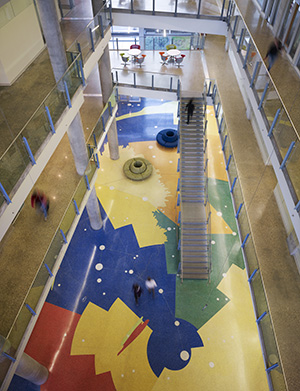 Walking across this floor should offer a sense of journey and discovery, like education itself. I would like for people to come, think, sit, and wonder-bridging their ideas and thoughts to what it is they have come here to study and what they see in the floor.
Walking across this floor should offer a sense of journey and discovery, like education itself. I would like for people to come, think, sit, and wonder-bridging their ideas and thoughts to what it is they have come here to study and what they see in the floor.
-floor artist Scott Parsons
Artist Scott Parsons designed the nearly 40,000 sq. ft. terrazzo floor for the Faculty of Science Centennial Centre for Interdisciplinary Science.
The design is a collaboration with the ONPA and Flad Architectural design team. The principal organizing element Parsons utilized for the floor design was to treat the surface with overlapping and interwoven imagery to visually bring together the multiple fields of inquiry: Integrated Earth and Landscape Management, Nanostructures and New Materials, Resource Geosciences, Chemical Biology and Proteomics, Planetary Dynamics, and Physics.
To accomplish this, he began by searching out what we share in common. Art, like science, shares a deeply rooted bond in an emotional, if not spiritual, sense of awe, and artists, like scientists, often begin their work from careful observation. The world is full of expression and gesture if we remain receptive to the unexpected, the overlooked, or the forgotten.
The construction of the floor can be seen in the online photo album. To aid in navigating the individual icons displayed in the floor, you can reference this guide to the science icons.
Points of Interest
As you journey through the Centennial Centre for Interdisciplinary Science, we invite you to explore several installations exhibiting some of the incredible science and research taking place in the Faculty of Science. Our outreach activities and facilities engage thousands of people each year and ignite interest in the next generation of scientists.
The Planets
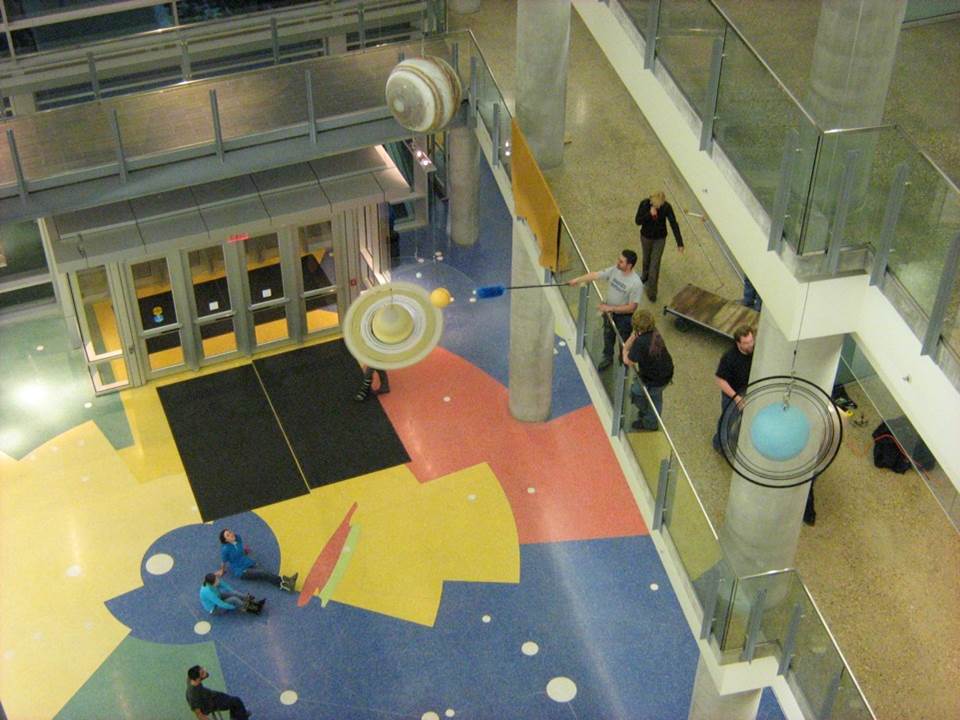
Reaching out of orbit to inspire imagination Location: Level One, CCIS |
Astronomy is a science that easily captures the collective imagination and can serve as a gateway to encourage people to develop interests in all areas of science. Generating, stimulating, and keeping that interest in science alive is important to the University of Alberta's Faculty of Science. The scale model of the solar system depicts the location of the planets on September 23, 2008, the 100th anniversary of the University of Alberta. There are three different length scales used in this installation to accommodate the space available. The distances between the planets and the Sun are all to the same scale. The sizes of the planets (and their rights) are to a different scale where the planets have been made larger to improve visibility. The sun has been shrunk in size compared to the planets so that it can fit into the atrium. For more information on the scales used, visit our Department of Physics Astronomical Observatory webpage. You can also visit the Observatory (on the 5th floor), boasting three domes with telescopes along with regularly scheduled public lectures and volunteers to provide interpretation. The solar system installation was made possible through a generous donation by the Royal Astronomical Society of Canada (Edmonton Centre). |
Baby Dinosaur

Little dinosaur, big discovery Location: Level Six, CCIS, Office of the Dean of Science |
In the badlands of Alberta's Dinosaur Provincial Park, University of Alberta professor Philip Currie discovered the fossil skeleton of a baby Chasmosaurus. This herbivore belongs to the ceratopsian (horned dinosaur) family. The fossil cast* of the skeleton shows how pristinely preserved the specimen is. Only the front limbs are missing-having eroded away sometime over the last few hundred years. Fossilized tendons crisscross the spinal column, and faint fossil skin impressions are visible on the flank. Learn more about ceratopsians and other dinosaurs in Dino 101, the University of Alberta's Massive Open Online Course. You can also visit the Paleontology Museum in the lower level of the Earth Sciences Building to see more specimens from the Laboratory for Vertebrate Paleontology. *The original fossil is extremely fragile and is used in research and teaching. |
Science and Art Series
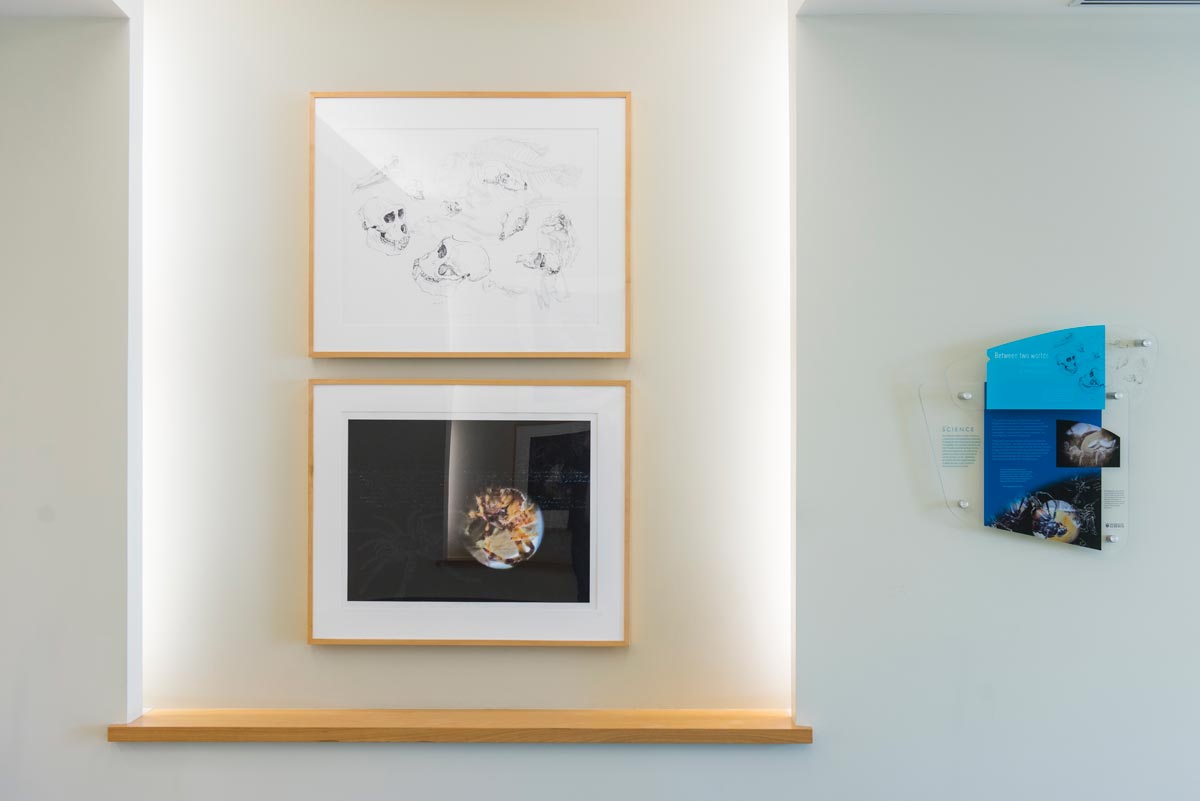
Between two worlds: the intersection of science and art Location: Level One, PCL Lounge/Bio Sci Link |
This series of drawings and digital prints by Ron Wigglesworth explores the connection between the two worlds of science and art. The series demonstrates that drawing complements and enhances scientific investigation, the acquisition of new knowledge, and the integration of previous knowledge. These specimens are from the University of Alberta's biology collections. The initial line drawings are analytic and focus on anatomical shape, texture, and line. The print images combine the line drawings with photography and text. The series visually links biological specimens with observational drawings then incorporates those observational drawings into the digital prints. Ron Wigglesworth gratefully acknowledges the assistance of the faculty and staff of the E.H. Strickland Entomological Museum, the Museum of Zoology, and the Departments of Biological Sciences, Art & Design, and Secondary Education. |
Rock and Mineral Specimens
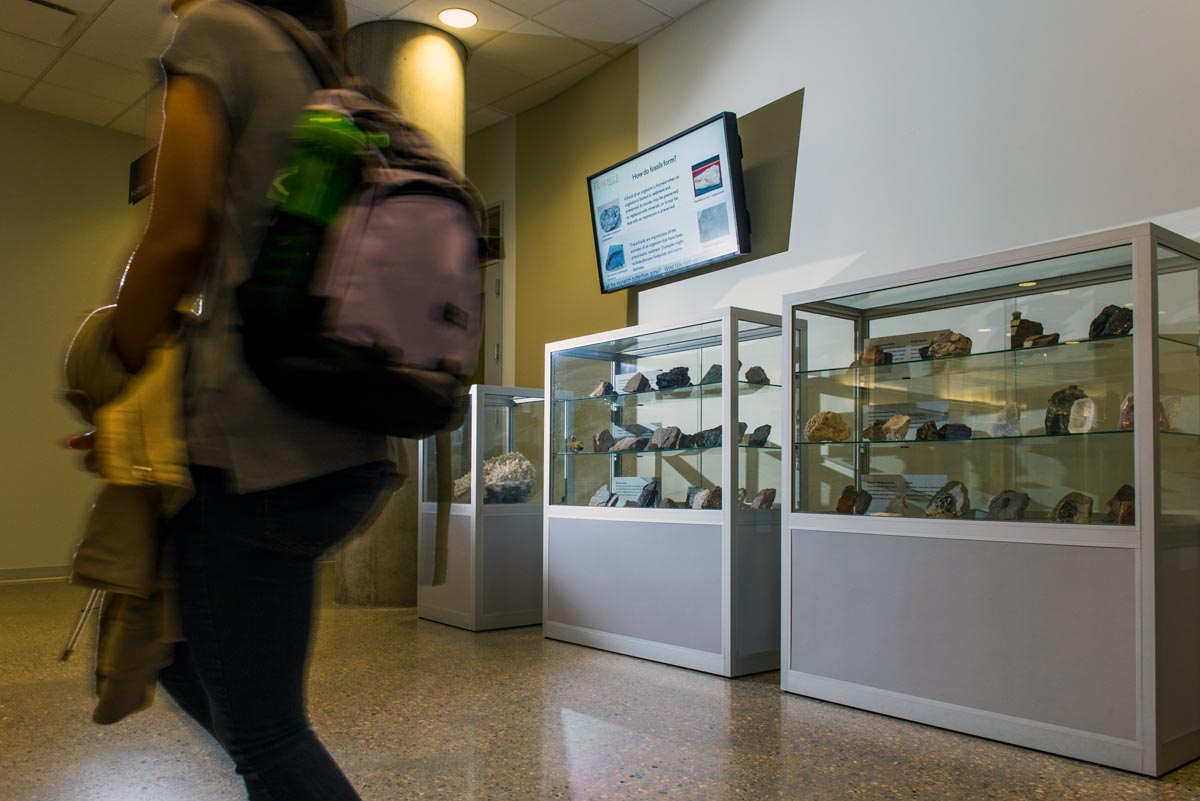 The best geologist is the one who sees the most rocks Location: Level Lower One, CCIS |
Minerals are the building blocks of rocks. The minerals presented here are organized systematically based on their elemental composition. The rocks are organized in the context of the rock cycle, illustrating the dynamic processes through which rocks form and change over geologic time. These specimens are used to support evidence and object-based-learning in undergraduate courses in the Department of Earth and Atmospheric Sciences. Observe even more specimens-including a touchable table-in the Mineralogy/Petrology Museum in the lower level of the Earth Sciences Building. |
Cloud Chamber
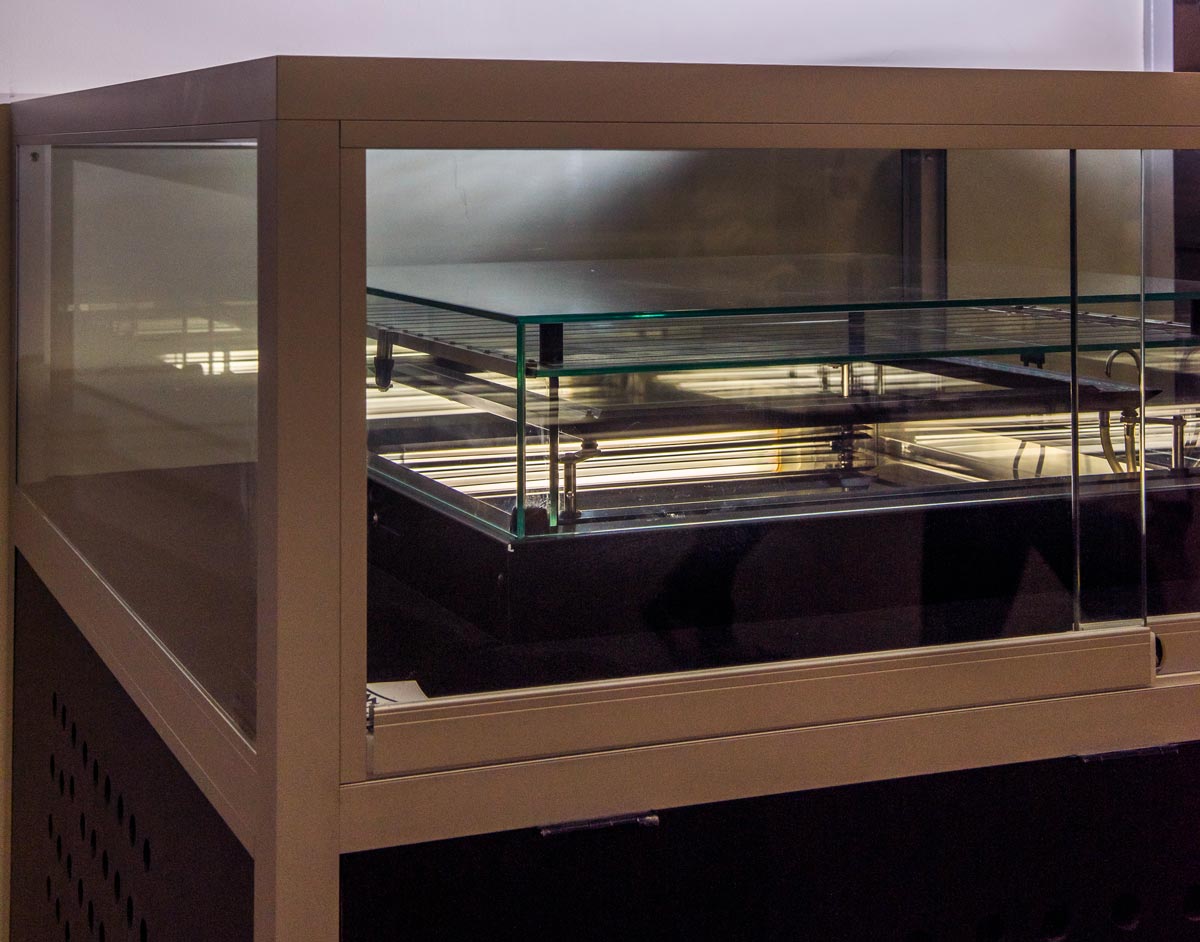
Cloud capture: observing the passage of subatomic particles Location: Level Lower Two, CCIS |
By itself, this cloud chamber does not produce any particles. It uses dry ice, liquid nitrogen, or mechanical refrigeration to establish a steep vertical temperature gradient-a warm layer at the top and a colder one near the bottom. Evaporating alcohol creates a volume of supersaturated vapor that condensates on ions left in the wake of charged particles. Tracks of alcohol droplets form in this region, indicating trajectories of the charged particles. Most subatomic particles recorded here are not the result of human activity but rather are caused by natural processes that have been present throughout the existence of life on earth. The majority of tracks are produced by either cosmic rays or environmental radionuclide decay (e.g., Radio-222 found in your basement). Using the tracks on the bottom of the cloud chamber, physicists can actually identify the kind of particles passing and, in some cases, can identify a scattering or a collision event. |
Scales of Science
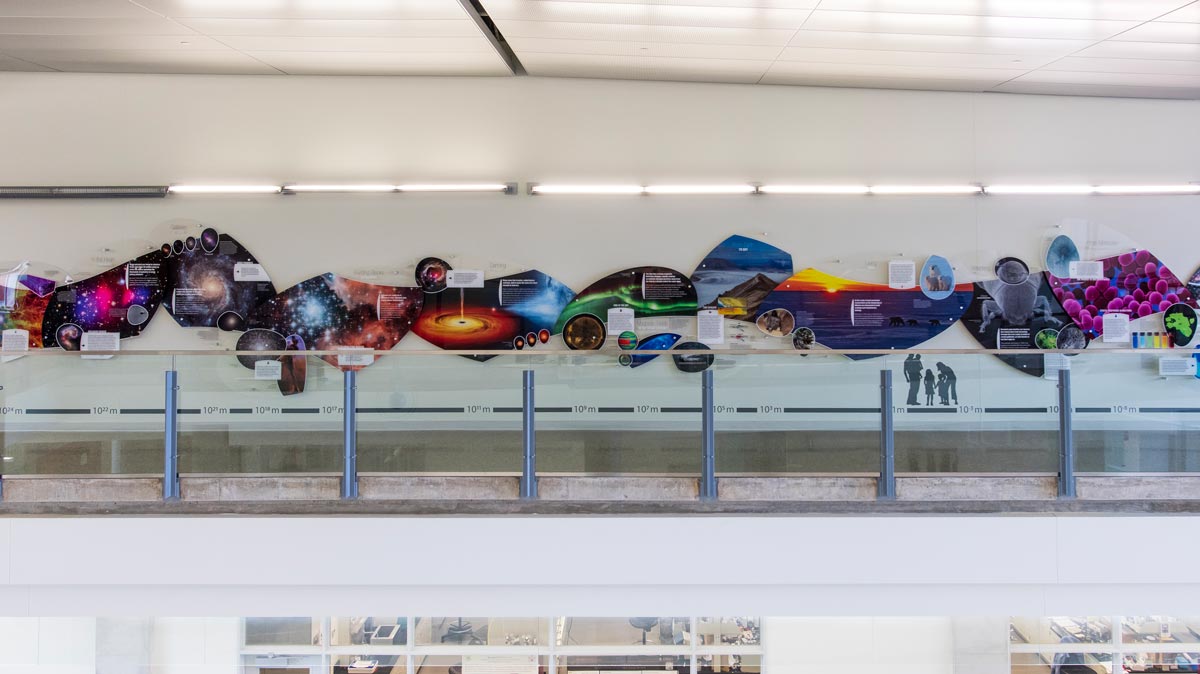
Sizing up science: from subatomic particles to the vast expanses of the universe Location: Level Five, CCIS |
With more than 300 faculty members, the range of topics we explore in the Faculty of Science is extremely diverse. Our science researchers study the smallest building blocks of matter up to the observable universe and everything in between, pushing the boundaries of knowledge with infinite possibilities. This exhibit focuses on a subsection of the research happening right here in the Centennial Centre for Interdisciplinary Science, highlighting research topics that are both quantifiable in and comparable by size. We feature a sampling of the discoveries made by researchers in biological sciences, chemistry, earth and atmospheric sciences, and physics. The subjects in each panel illustrate the science associated with different lengths, ranging from the smallest size at the far right progressing through increasingly larger sizes to the left until the whole visible universe is reached before the entrance of the Department of Physics Astronomical Observatory. The panels do not have to be experienced in any particular order. |
The Foucault Pendulum

Illustrating Earth's rotation: The Foucault pendulum Location: Level One, CCIS |
How can you show that Earth spins? Back in 1851, the French physicist Jean-Bernard-Leon Foucault created a simple experiment to prove the Earth spins on its axis once every 24 hours. This experiment is now called a Foucault pendulum. Our Foucault pendulum is used in undergraduate physics classes as well as public outreach events. For demonstrations, we attach a heavy weight to the wire hanging over the star Polaris (on the floor). The wire-26.4 metres in length when unwound-is free to swing in any direction. To demonstrate the rotation of the Earth, props are arranged in a circle. The pendulum is set swinging in a line with no obstruction. Within a few minutes, the rotation of the Earth causes the plane of the swinging weight to rotate, and the props are knocked over. Undisturbed, our pendulum would swing clockwise and make a full rotation in 19.3 hours, indicating a full rotation of Earth at Edmonton's latitude of 53.5 degrees. |
Plesiosaur

It's a bird, it's a plane, it's a plesiosaur! Meet the newest addition to the Faculty of Science family Location: Level One, CCIS |
Soaring through the sky in the Centennial Centre for Interdisciplinary Science swims a Cretaceous sea monster. Spanning 50 feet from head to tail, the Elasmosaurus platyurus belongs to a group of ancient long-necked reptiles-plesiosaurs-that, along with ichthyosaurs and mosasaurs, dominated the world's oceans while dinosaurs ruled the land. The new specimen will not only be a showpiece for the building, it will also be used for teaching undergraduate paleontology courses. Students around the world can learn about ancient marine reptiles with a mini massive open online course (MOOC) on Coursera. |